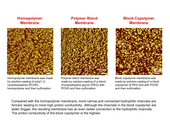Highlight
Next Generation Proton Exchange Membranes for Fuel Cells
Achievement/Results
Dr. Jimmy Mays and Dr. Suxiang Deng comprise the synthetic group within the STAIR (Sustainable Technology through Advanced Interdisciplinary Research) program at the University of Tennessee Knoxville. This group has modified the synthesis of poly(1,3-cyclohexadiene)-based proton exchange fuel cell membranes by blending or copolymerizing poly(ethylene glycol) (PEG) to successfully exceed the proton conductivity requirement specified by the Department of Energy’s (DOE) Year 3 Milestone.
Membranes were easily made by (1) solution-casting of poly(1,3-cyclohexadiene)(PCHD) homopolymers, polymer blends, or PCHD-PEG block copolymers; and (2) sulfonation. Proton conductivities were greatly enhanced by: (1) blending 20 wt% PEG into PCHD, which almost doubled the proton conductivity; and (2) coplymerizing 9.5 wt% PEG with PCHD, which increased proton conductivity by 10 times as compared with Nafion. Block copolymers are two polymers tied together with a chemical bond, while a polymer blend is just a physical mixture of these two polymers. Block copolymer fuel cell membranes have proton conductivity as high as 174 mS/cm at 120°C and at 50% relative humidity, which exceeds the proton conductivity requirement specified by DOE’s Year 3 Milestone (100 mS/cm at 120°C and at 50% relative humidity). High proton conductivity is the controlling property of fuel cell membranes and essential to support high currents with minimal resistive losses. Therefore, achieving such high proton conductivity with our modified synthesis is of great significance.
With Atomic Force Microscopy (AFM) images, we observed a correlation between morphology and proton conductivity. AFM images can only provide morphology information on the surface. Morphology features inside membranes, such as interconnected hydrophilic proton conducting channels, can be obtained by microscopy study and molecules simulation, both of which can be available only through the interdisciplinary teamwork in this Integrative Graduate Education and Research Traineeship (IGERT) project. The morphology insights gained from this IGERT project will be very useful for our group to further optimize synthetic conditions for high performance proton exchange fuel cell membranes. STAIR, funded by the National Science Foundation, is an interdisciplinary IGERT research and training grant under the direction of Dr. Barry Bruce, Dr. Paul Frymier, Dr. David Keffer, Dr. Bamin Khomami and Dr. Claudia Rawn.
Address Goals
The synthesis, characterization and modeling of these new proton exchange membranes (PEMs) constitute an important advance in the understanding of the relationship between membrane structure and proton transport. These membranes can potentially replace existing membrane materials, at lower cost and with superior performance. The work is interdisciplinary because the synthesis has been performed by the Mays research group (Chemistry) and will be characterized by the Joy research group (Materials Science Engineering) and modeled by the Keffer research group (Chemical and Biomolecular Engineering).







